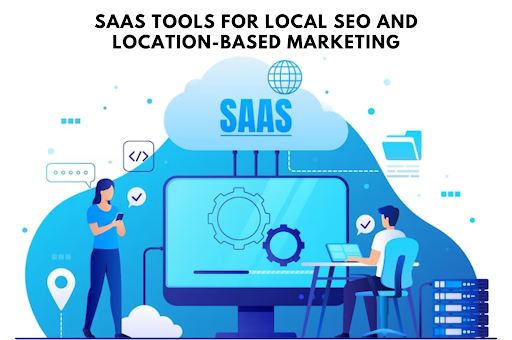As consumers increasingly turn to search engines and mobile devices to discover local products and services, mastering Local SEO and Location-Based Marketing has become paramount for success. Fortunately, the advent of Software-as-a-Service (SaaS) tools has revolutionized the way businesses can optimize their local presence and engage with their target audience.
We will learn how SaaS Tools for Local SEO and Location-Based Marketing are useful, exploring how these innovative solutions can empower businesses to thrive in their local markets. We will highlight the key benefits of using SaaS tools for local optimization, examine essential features to consider, and present a curated list of top-performing tools that have proven their efficacy in boosting online visibility and driving foot traffic.
Location-Based Marketing: How It Works and Its Impact on Businesses
Location-Based Marketing is a powerful digital marketing strategy that leverages a user’s geographic location to deliver targeted and relevant content, advertisements, or promotions. This approach utilizes location data from mobile devices, beacons, or GPS technology to deliver personalized messages and experiences to consumers based on their physical proximity to a business or point of interest. The impact of Location-Based Marketing on businesses has been significant, revolutionizing the way they interact with customers and enhancing their overall marketing efforts.
How It Works:
Location-Based Marketing operates on the principle of delivering contextually relevant content to consumers based on their real-time location.
The process typically involves the following steps:
Geotargeting: Businesses use geotargeting to define specific geographic areas, such as cities, neighborhoods, or even a radius around their physical store locations. This establishes the target audience for location-based campaigns.
Location Data Collection: Location data is gathered from various sources, including GPS signals from mobile devices, check-ins, or data from location-based apps. Beacons placed in physical locations can also facilitate the collection of precise location information.
Personalized Content Delivery: With access to users’ location data, businesses can deliver personalized content, such as special offers, discounts, or event notifications, directly to their mobile devices when they are within the defined geographical area.
Real-Time Engagement: Location-Based Marketing enables real-time engagement with consumers. When a potential customer is in proximity to a business, timely and relevant messages can prompt immediate action, such as visiting the store or making a purchase.
The Impact on Businesses:
Enhanced Customer Engagement: Location-Based Marketing allows businesses to engage with customers at the right place and time, increasing the likelihood of driving foot traffic to physical stores or encouraging online conversions.
Improved Targeting and Relevance: By delivering personalized content based on the user’s location, businesses can provide relevant offers, recommendations, and information, leading to higher conversion rates and customer satisfaction.
Increased Foot Traffic and Sales: Leveraging location-based promotions and incentives can attract nearby consumers to visit physical stores, boosting foot traffic and potential sales opportunities.
Better Customer Insights: Analyzing location data and user behavior can provide valuable insights into customer preferences, allowing businesses to refine their marketing strategies and offer more targeted experiences.
Geofencing Opportunities: Geofencing is a popular tactic within Location-Based Marketing that allows businesses to trigger actions, such as notifications or advertisements, when a user enters or exits a predefined geographic area. This level of precision targeting enhances marketing effectiveness.
Competitive Advantage: Implementing Location-Based Marketing can differentiate businesses from competitors, demonstrating a commitment to providing relevant and personalized experiences to customers.
Advantages of Using SaaS Tools for Local SEO and Marketing
In the realm of Local SEO and Location-Based Marketing, the adoption of Software-as-a-Service (SaaS) tools brings an array of advantages that can revolutionize a business’s online visibility and marketing efforts.
Here are the key advantages of incorporating SaaS tools into your local marketing strategy:
Accessibility and Convenience: SaaS tools are cloud-based, enabling easy access from any internet-connected device. This accessibility ensures that businesses can manage their local SEO and marketing campaigns from anywhere, without the need for complex installations or dedicated hardware.
Cost-Effectiveness: SaaS tools follow a subscription-based pricing model, eliminating the need for significant upfront investments in software licenses or infrastructure. This cost-effectiveness is especially beneficial for small and medium-sized businesses with limited budgets.
Scalability: As businesses grow or expand their local presence, SaaS tools can effortlessly accommodate increasing demands. Scaling up or down becomes seamless, allowing businesses to adapt to changing market needs without any disruption.
Regular Updates and Maintenance: SaaS providers are responsible for maintaining and updating the tools, ensuring that businesses always have access to the latest features and security enhancements without the burden of manual updates.
User-Friendly Interfaces: Most SaaS tools are designed with user-friendliness in mind, making them accessible to marketing teams with varying levels of technical expertise. Intuitive interfaces and guided workflows streamline the execution of local SEO and marketing campaigns.
Data Security and Backup: Reputable SaaS providers prioritize data security and offer robust backup measures, safeguarding businesses from data loss or breaches. This ensures that sensitive customer information and marketing data remain protected.
Integration Capabilities: Many SaaS tools offer seamless integration with other essential marketing platforms and analytics tools. This integration streamlines data sharing, reporting, and analysis, providing a comprehensive view of marketing performance.
Real-Time Analytics: SaaS tools often provide real-time analytics and performance metrics, enabling businesses to track the impact of their local SEO and marketing efforts immediately. This data-driven approach allows for quick adjustments and optimization to maximize results.
Competitive Edge: Leveraging advanced features and functionalities of SaaS tools can give businesses a competitive edge in their local markets. They can stay ahead of competitors by employing cutting-edge technologies and strategies.
Focus on Core Competencies: By outsourcing the technical aspects of local SEO and marketing to SaaS tools, businesses can concentrate on their core competencies and devote more time and resources to other critical areas of their operations.
Local SEO Best Practices for Long-Term Success
Local SEO is a fundamental strategy for businesses looking to establish a strong online presence and attract customers from their local communities. To ensure long-term success in local search rankings and customer engagement, here are some essential Local SEO best practices to follow:
Optimize Google My Business (GMB) Listing:
- Claim and verify your business listing on Google My Business.
- Provide accurate and up-to-date business information, including address, phone number, website, and business hours.
- Select the appropriate primary and secondary business categories.
- Encourage customer reviews and respond to them promptly.
Consistent NAP Information:
- Ensure your business name, address, and phone number (NAP) are consistent across all online directories, websites, and social media platforms.
- Use the same formatting and details for NAP information to avoid confusion.
Local Keyword Research:
- Conduct thorough keyword research to identify relevant and location-specific keywords.
- Include local keywords in your website content, meta tags, headings, and URLs.
On-Page Optimization:
- Create location-specific landing pages or sections on your website for each business location (if applicable).
- Optimize meta titles, meta descriptions, and headings with relevant local keywords.
- Include your NAP information on every page of your website.
Local Citations and Business Listings:
- Build consistent and accurate citations on reputable local directories, industry-specific platforms, and mapping services.
- Ensure your NAP information matches the details on your website and GMB listing.
Online Reviews and Reputation Management:
- Encourage customers to leave reviews on platforms like Google, Yelp, and other relevant review sites.
- Respond to both positive and negative reviews professionally and promptly.
- Monitor and manage your online reputation regularly.
Mobile Optimization:
- Ensure your website is mobile-friendly and responsive to provide a seamless experience for mobile users.
- Optimize loading speed and design for mobile devices.
Local Link Building:
- Seek backlinks from local businesses, organizations, and community websites.
- Participate in local events, sponsorships, or partnerships to earn local links.
Location-Based Content:
- Create valuable and informative content that is relevant to your local audience.
- Highlight local events, news, or stories that resonate with your target customers.
Social Media Engagement:
- Engage with your local community on social media platforms.
- Post relevant updates, events, and promotions regularly.
- Monitor Analytics and Performance:
- Track and analyze the performance of your local SEO efforts using tools like Google Analytics and GMB Insights.
- Make data-driven decisions to optimize your strategy over time.
By implementing these Local SEO best practices consistently and continuously monitoring your performance, your business can achieve long-term success in local search rankings, attract local customers, and establish a strong online presence in your target geographical area.
Conclusion
In conclusion, mastering Local SEO best practices is crucial for businesses seeking sustained success in their local markets. By optimizing Google My Business, maintaining consistent NAP information, and conducting local keyword research, businesses can enhance their online visibility and attract targeted customers. Building a strong online reputation through reviews and engaging with the local community on social media further solidifies their position. Mobile optimization, location-based content, and continuous monitoring of analytics ensure a seamless user experience and data-driven improvements. Embracing these Local SEO best practices empowers businesses to thrive in the ever-evolving digital landscape, fostering lasting connections with local customers and reaping the rewards of long-term success.

